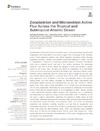Identificador persistente para citar o vincular este elemento:
https://accedacris.ulpgc.es/jspui/handle/10553/57436
| Título: | Zooplankton and Micronekton Active Flux Across the Tropical and Subtropical Atlantic Ocean | Autores/as: | Hernández-León, Santiago Olivar, María Pilar Fernández de Puelles, María Luz Bode, Antonio Castellón, Arturo López-Pérez, Cristina Tuset, Víctor M. González-Gordillo, José Ignacio |
Clasificación UNESCO: | 251001 Oceanografía biológica | Palabras clave: | Electron-Transport-System Organic-Carbon Vertical Distributions Chemical-Composition Mesopelagic Fishes, et al. |
Fecha de publicación: | 2019 | Proyectos: | "Migradores y Flujo Activo en El Océano Atlántico" Biomasa y Flujo Activo en la Zona Batipelágica |
Publicación seriada: | Frontiers in Marine Science | Resumen: | Quantification of the actual amount of carbon export to the mesopelagic layer by both zooplankton and micronekton is at present a gap in the knowledge of the biological pump. These organisms perform diel vertical migrations exporting carbon through respiration, excretion, mortality, and egestion during their residence at depth. The role of zooplankton in active flux is nowadays partially assessed. However, micronekton active flux is scarcely known and only a few studies addressed this downward transport. Even less is known about the capacity of both communities to export carbon in the ocean. Here, we show the results of zooplankton and micronekton active flux across a productivity gradient in the tropical and subtropical Atlantic Ocean. Biomass vertical distribution from the surface up to 800 m depth by day and night was studied during April 2015 in a transect from 9°S to 25°N, covering from the quite oligotrophic zone off Brazil to the meso- and eutrophic areas of the equator, Guinea Dome, and the oceanic upwelling off Northwest Africa. Zooplankton and micronekton migrant biomass was estimated from day and night catches at different layers of the water column using MOCNESS-1 (1 m2 mouth area) and Mesopelagos (35 m2) nets, respectively. Respiratory flux was assessed by measuring the enzymatic activity of the electron transfer system (ETS) of organisms at depth. Results showed a close relationship between migrant biomass and respiratory flux in zooplankton and micronekton as expected. Using a rather conservative 50% of efficiency for the net used to capture micronekton, respiratory flux resulted in similar values for both communities. Gravitational (passive) flux measured using sediment traps increased from the oligotrophic toward the meso- and eutrophic zones. Total active flux (including respiration and estimated mortality, excretion, and gut flux) by zooplankton and micronekton accounted for about 25% of total flux (passive plus active) in oligotrophic zones. Total active flux also increased toward meso- and eutrophic zones, reaching about 80% of total flux and being at least twofold higher than passive flux. These results alert about an important underestimation of the ocean biological pump using only passive flux measurements. | URI: | https://accedacris.ulpgc.es/handle/10553/57436 | ISSN: | 2296-7745 | DOI: | 10.3389/fmars.2019.00535 | Fuente: | Frontiers in Marine Science [ISSN 2296-7745], v. 6 (535), (Septiembre 2019) |
| Colección: | Artículos |
Citas SCOPUSTM
62
actualizado el 08-jun-2025
Citas de WEB OF SCIENCETM
Citations
60
actualizado el 08-jun-2025
Visitas
99
actualizado el 23-mar-2024
Descargas
120
actualizado el 23-mar-2024
Google ScholarTM
Verifica
Altmetric
Comparte
Exporta metadatos
Los elementos en ULPGC accedaCRIS están protegidos por derechos de autor con todos los derechos reservados, a menos que se indique lo contrario.
